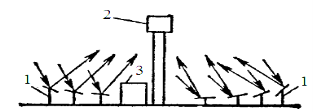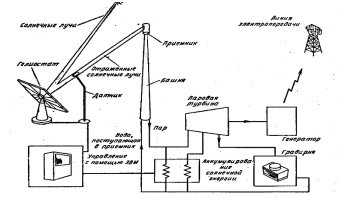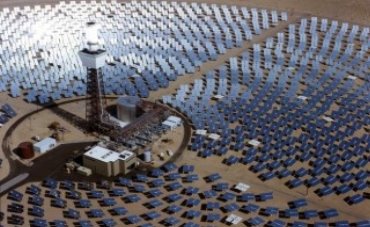В статье рассматриваются типы и виды солнечных тепловых электрических станций башенного и модульного типа, принцип работы солнечной тепловой электрической станции, гелиостатов, принципиальная схема башенной солнечной тепловой электрической станции, а также интенсивность излучения Солнца и падающей солнечной радиации на поверхность земли. Представлены способы концентрации солнечной энергии современными технологиями, описываются элементы гелиоэнергетических установок башенного типа, факторы зависимости солнечного излучения.
Ключевые слова: солнечная тепловая электрическая станция (СТЭС) башенного типа, СТЭС модульного типа, гелиостат
The main source of energy for our planet is solar energy. It is the Sun that is the ancestor of all the major energy resources used by mankind. The sun heats up the atmosphere and the surface of the Earth, so that the winds blow, rivers flow, plants develop, organic fuels are formed.
The sun is a massive, intensely luminous gas ball consisting mainly of hydrogen (70 per cent) and helium (27 per cent). Thermonuclear reactions occur constantly in the depths of the Earth, followed by the emission of a large amount of energy. The radiation intensity on the surface of the Sun is 70–80 thousand kW / m 2 at a temperature of about 6000 ° C.
Actually, solar thermal power plants are being installed, primarily of two forms of STPP style tower and STPP model dispersed (modular). The idea behind the work of a tower-type solar power station was put forward more than 350 years ago, but the construction of this type of power plant began only in 1965, and a number of powerful solar thermal power plants were built in the USA, Western Europe, the former Union and other countries in 1980.
The theory of operation of a tower-type solar thermal power plant is very easy, but it is necessary to solve several difficult problems before the cost of electricity generated at these plants becomes equal to the cost of energy produced at conventional thermal power plants. Such power plants were based on the principle of the creation of water vapor through solar radiation. In the middle of the plant there is a tower with a height of 18 to 24 meters (depending on the capability and some other factors, the height may be higher or lower) at the top of which there is a water tank. The tank is painted black to absorb thermal and visible radiation. There are also pumps in the tower that deliver water to the turbo-generator tank outside the tower. There are heliostats around the tower at a distance from the tower.

Fig. 1. Scheme of the tower STPP: 1 — heliostats; 2 — central radiation receiver; 3 — station equipment
Heliostat is a mirror of several square meters area, fixed on a support and connected to the general positioning system. That is, depending on the position of the Sun, the mirror will change its orientation in space. The main and most difficult task is to position all the mirrors of the station so that at any time all the reflected rays from them fell on the tank. In clear sunny weather the temperature in the tank can reach 700 0 C. These temperature parameters are used in most conventional thermal power plants, so standard turbines are used to generate energy. In fact, this type of power plant can produce relatively high efficiency. (about 20 %) and high capacity.
As a rule, the tower, on top of which the solar energy receiver is fortified, is located on the southern edge of the heliostat field — the mirrors that make a turn after the sun around two mutually perpendicular axes. Mirrors send reflected sunlight to a heat receiver, where solar heat is used to produce high-temperature steam, which is then fed into a Rankin-cycle turbine unit. This process is shown schematically in Figure 2.

Fig. 2. Schematic diagram of the tower STPP
333 heliostats of 37 m 2 each reflect the rays of the sun on the receiver at the Albuquerque tower-type solar power plant. On the receiver surface a maximum energy illumination of 2.5 MW / m 2 was recorded.

Fig. 3. Appearance solar power plant
The total capacity of the radiant energy supplied to the Earth's atmosphere is about 180,000 billion kW. The amount of solar radiation energy that enters the Earth's atmosphere through the atmosphere during the year is significant — 1.5*10 18 kWh. Because of the reflection and dissipation of its absorption by atmospheric gases and aerosols, only 47 % of all energy, or approximately 7*10 17 kWh, reaches the earth's surface.
Solar radiation in the Earth's atmosphere is divided into so-called direct radiation and scattered particles of air, dust, water, etc., contained in the atmosphere. The sum of the direct and scattered radiation falling on the horizontal surface of the earth represents the total solar radiation.
To quantify solar radiation, the amount of energy transported per unit of time (energy flux) through a single site, the radiation intensity I e , is used. Unit of measurement I e in the SI system: — Watt per square meter (W/m 2 ).
The intensity of solar radiation depends on many factors: latitude, surface tilt relative to the Sun, local climate, clouds, air dust, altitude, season and time of day. In middle latitudes during the day, the intensity of solar radiation /achieves 800 W/m 2 in summer and 200...350 W/m 2 in winter, decreasing to zero with sunset.
Technologies for converting the radiant energy of the Sun into electricity are younger and based on modern scientific and technological progress. Two options for converting solar radiation energy into electricity are possible: direct or indirect.
Indirect conversion is carried out by means of radiation concentration with the help of tracking mirrors with the subsequent conversion of water into steam and generation of electric energy in the traditional way.
Direct conversion of solar energy into electrical energy is carried out by means of thermoelectric or photovoltaic converters.
A classic example of the use of solar radiation for the production of thermal and electrical energy is solar thermal power plants (STPPs).
According to the method of heat production, STPP sare divided in to solar concentrators (mirrors), solar ponds.
References:
- Abduraxmanov A. A., Sobirov Y. B., Quchqarov A. A., Axadov J. Z., Xolov Sh. Nablyudeniye i control osveshennosti mestnosti rospolojeniya BSP s teplovoymoshnostyu 1 MVt // Nauchno-texnicheskiy jurnal Ferganskogo politexnicheskogo instituta, 2013. № 3. S.78–82.
- Mixaylov A. Solnsevmestonefti. //Profil: jurnal. –M., 2016. — 30 maya (№ 19(953)), S.
- P. B. Loubser, A. R. Jacobs Optimised design of wind turbine gravity foundations Insights and Innovations in Structural Engineering, Mechanics and Computation — Zingoni (Ed.) 2016.
- Сolloquium-journal. № 10(21). Część 1 (Warszawa, Polska). 2018. С.64–66.
- www.renewable-energy-world.com
- 2013 Renewable Energy Data Book. National Renewable Energy Laboratory (NREL). http://www.nrel.gov/docs/fy15osti/62580.pdf
- http://www.steagsystemtechnologies.com/ebsilonprofessional.html
- http://www.energy.iastate.edu
- http://www.repp.org/repp_pubs/articles/resRpt11/preleasesubsidies







